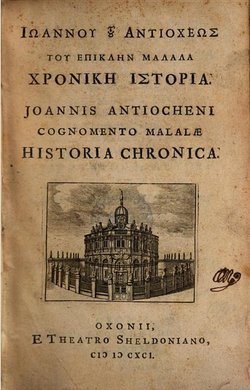John Malalas
John Malalas (
Life
Of
Malalas was educated in Antioch, and probably was a
Writing

He wrote a Chronographia (Χρονογραφία) in 18 books, the beginning and the end of which are lost. In its present state it begins with the mythical history of
Malalas cites many sources, including the lost or fragmentary works of Brunichius, Charax of Pergamum, Domninus, Eustathius of Epiphania, Eutropius, Eutychianus, Nestorianus, Philostratus, Priscus, Sisyphus of Kos and Timotheus.[10]
The work is important as the first surviving example of a chronicle written not for the learned but for the instruction of the monks and the common people,[6] and its language shows a compromise with the spoken language of the day, although "it is still very much a written style. In particular, he employs technical terminology and bureaucratic clichés incessantly, and, in a period of transition from Latin to Greek governmental terminology, still uses the Latin loanwords alongside their Greek replacements ... The overall impression created by Malálas' style is one of simplicity, reflecting a desire for the straightforward communication of information in the written language of everyday business as it had evolved under the influence of spoken Greek."[11]
It obtained great popularity, and was used by various writers until the ninth century; it was translated into
See also
References
- ^ "John Malalas | Byzantine chronicler". Encyclopedia Britannica. Retrieved 2021-01-25.
- ISBN 978-1-4411-0105-1.
- ^ Thurn, Ioannis Malalae Chronographia, p. 1.
- ISBN 0-582-30709-0), p. 180.
- ^ Thurn, Ioannis Malalae Chronographia, p. 1.
- ^ a b c d One or more of the preceding sentences incorporates text from a publication now in the public domain: Chisholm, Hugh, ed. (1911). "Malalas, John". Encyclopædia Britannica. Vol. 17 (11th ed.). Cambridge University Press. p. 461.
- ^ Thurn, Ioannis Malalae Chronographia, p. 2.
- ISBN 0-8047-2421-0), p. 267.
- ^ Thurn, Ioannis Malalae Chronographia, p. 2.
- ^ Elizabeth Jeffreys, "Malalas' Sources", in Elizabeth Jeffreys, Brian Croke and Roger Scott (eds.), Studies in John Malalas (Brill, 1990), p. 196.
- ^ Horrocks, Greek, pp. 179-81, q.v. for details of lexical and syntactic usage; see also pp. 181-82 for a passage of Malalas with interlinear translation and transcription showing how Horrocks believes it would have sounded in the spoken Greek of the day.
- ^ Oleg Tvorogov, Хроника Иоанна Малалы Archived 2009-05-17 at the Wayback Machine.
- ISBN 0-19-504652-8.
Modern editions
- Text
- Johannes Thurn (ed.) 2000, Ioannis Malalae Chronographia, ISBN 3-11-008800-2
- Translation
- Elizabeth Jeffreys, Michael Jeffreys, Roger Scott et al. 1986, The Chronicle of John Malalas: A Translation, Byzantina Australiensia 4 (Melbourne: Australian Association for Byzantine Studies) ISBN 0-9593626-2-2
- Downey, G., ed. (1940). Chronicle of John Malalas, books VIII—XVIII. University of Chicago Press.
Further reading
- E. Jeffreys, B. Croke, and R. Scott (eds.), Studies in John Malalas (Sydney: Australian Association for Byzantine Studies, 1990) (Byzantina Australiensia, 6), pp. 1–25.
- David Woods, "Malalas, Constantius, and a Church-inscription from Antioch," Vigiliae Christianae, 59,1 (2005), pp. 54–62.
- J. H. W. G. Liebeschuetz, "Malalas on Antioch," in Idem, Decline and Change in Late Antiquity: Religion, Barbarians and their Historiography (Aldershot, Ashgate, 2006) (Variorum Collected Studies).
External links
- Chronicle of John Malalas (full, translated)
- Translation of the 8th book of Malalas' Chronographia
- Greek Opera Omnia by Migne Patrologia Graeca with analytical indexes
- Catholic Encyclopedia (1910 ed.), John Malalas"
- Malalas, Chronography (online English translation, open access)
